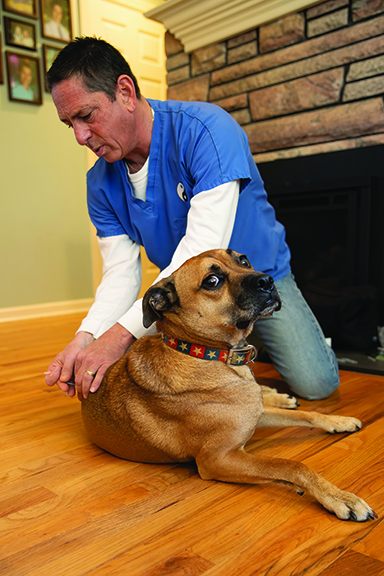 Melo, a beautiful brown mixed-breed dog, lies on the floor breathing calmly while veterinarian Dr. Michael Brodsky, a certified canine acupuncturist, inserts the next needle in his therapy. Yes, you read that correctly…Melo, the dog, is receiving acupuncture!
Melo, a beautiful brown mixed-breed dog, lies on the floor breathing calmly while veterinarian Dr. Michael Brodsky, a certified canine acupuncturist, inserts the next needle in his therapy. Yes, you read that correctly…Melo, the dog, is receiving acupuncture!
Long touted for its health benefits in humans, acupuncture has its roots in traditional Chinese medicine and has been used for thousands of years. It works by restoring the flow of energy, or chi, throughout the body. In Western medicine, acupuncture is believed to work by stimulating neural-hormonal pathways releasing hormones that reduce pain and inflammation. The needles are also believed to improve blood circulation at the points of insertion.
The history of acupuncture in animals is long. One of the first veterinary acupuncture texts, Bole’s Canon of Veterinary Acupuncture, was written by a Chinese veterinarian that lived from 659–621 BC. The practice spread from China to Japan and then Korea, and came to the Western world via France in the 1500s. In the 1800s it arrived in North America. Today, outside of Asia, canine acupuncturists are certified by The International Veterinary Acupuncture Society (IVAS), a non-profit organization founded in 1974 and dedicated to promoting excellence in the practice of veterinary acupuncture as an integrative part of veterinary medicine.
“Acupuncture in dogs is most commonly used to treat older, large breed dogs who have developed arthritis or degenerative joint disease in their hips, knees or elbows either due to age or injury,” said Dr. Brodsky. “And unlike humans, there is no placebo effect. It really works! The dogs go from being sedentary, to having a noticeably better quality of life according to their owners.”
During the first appointment, expect the acupuncturist to ask questions about your dog’s health and conduct a physical exam. The first visit takes about an hour, with follow-up therapy sessions lasting about 30-45 minutes. A typical follow-up session starts with a discussion of any differences, improvements or problems since the last visit. The dog lays on the floor or in their dog bed, whatever makes them most comfortable. The first needle is always placed at the crown of the head because it causes a calming effect. The dogs will often roll onto their side, start deep breathing or have their noses run, which is a sign of relaxation. Subsequently, more needles are placed at specific points along energy channels, similar to human acupuncture. They are left in for about 15-20 minutes then removed. Every needle is for single-use only and every treatment plan is individualized to the specific dog and its issues.
Most animals benefitting from acupuncture are experiencing some level of pain or stiffness especially when getting up or laying down. Climbing stairs is also a big issue. Owners tend to notice increased mobility in the first couple of treatments, with effects sometimes resulting in the reduction or complete elimination of pain or anti-inflammatory medications. A key benefit for many dog owners is that unlike medication, there is no side effect to acupuncture therapy.
One of Dr. Brodsky’s Bedford clients calls him a ‘dog whisperer’ and couldn’t believe the difference acupuncture made in the life of their aging Golden Retriever named Jamaica.
“In the summer of 2020 Jamaica was diagnosed with arthritis and we’d noticed a marked decrease in her mobility. An orthopedic veterinarian recommended we try acupuncture for our beautiful girl along with some pain medication to keep her comfortable. We called Dr. Brodsky and after just two treatments we saw a marked difference in her activity level,” said Jamaica’s owner.
Jamaica continued to receive treatments every week for the next two years, including with an acupuncturist in Barbados where the family spends Christmas every year. “Watching Jamaica blossom, especially during Covid, was really a silver lining,” continued Jamaica’s owner.
Jamaica passed away earlier this year, but the owner’s overwhelming sentiment is that acupuncture contributed to the quality of her life during those last few years. “She could go for long walks with us again, go up stairs, climb elevations when we went hiking, and best of all, she wasn’t on any medicine except for a joint supplement once a week,” says her owner.
Different veterinarians work in different ways, either conducting their sessions in a hospital practice or doing house calls. Generally, the calmer the dog is during the therapy the more profound the benefit. When considering acupuncture for your pet the most important thing to look for is a vet who is a Certified Veterinary Acupuncturist (CVA). A CVA has comprehensive training in acupuncture as well as western veterinary medicine.
If you think your fur-baby could benefit from acupuncture therapy, reach out to Dr. Brodsky directly at 203-403-3196 or search for a certified veterinarian acupuncturist on the IVAS website. •